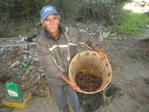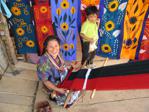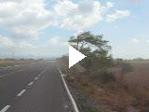After a morning television news interview, I left Oaxaca and rode three days through steep dry mountains and deep valleys before arriving on coastal plains of the Gulf of Tehuantepec. At sea level for the first time in over a month, I found the mid-day heat almost unbearable and was almost pleased when winds gusting over 50 mph blew from the north (video right).
On this coastal plain, I turned off the main road to take a 20 mile detour to the ocean. At the tiny town of Ceritos, I made a critical error and turned right instead of left. After ten kilometers of biking sandy roads, found myself at an impassible canal connected to an inland sea, still far from the Pacific as dark fell.
A group of shrimp fishermen, consisting of a man, his brother, and three of his sons, told me of my error, and then invited me to spend the night at their camp. Shrimp apparently only move at night, and the fishermen have check and place their nets in the middle of the night. Between checking their nets, they slept on wood planks, and had built a small wall around their fire to keep out the persistent wind.


Baltasar, a man of 55, after expressing pride in his 5 children and explaining to me why he enjoyed shrimp fishing, told me that in his 40 years of shrimp fishing at this camp, I was the first gringo he had seen here. I asked if he ever saw gringos in his home town, to which he said ‘sometimes, but they all turn left.’ I asked the fishermen if they liked their work, to which they said, ‘Yes, it pays well,’ but remarked that in recent years they have caught fewer shrimp as more fishermen had started fishing. That night, the 5 men caught a total of 2 kilos, which could be sold for about $8.
In the morning I biked with Baltasar to his town (photo above), and then, turning left instead of right, followed a dirt road to the Pacific Ocean. On a beach devoid of services or tourists, I spent an hour in the shade of a fishing camp, meeting yet more local fishermen. Soon, the fishermen had me help carry nets and anchors and invited me to jump in their 20 ft boat, spending the next two hours motoring along the coast while they placed nets. Riding many kilometers along the shore, I saw a coastline completely devoid of people, and only a thin strip of sand between palm trees and shoreline vegetation.
Perhaps there are not tourists here because it is incredibly windy – almost all of the time, a huge wind blows from the north, from the land towards the ocean. In the photo on the right, you can see the sand storm I had to bike through to leave the beach.
After sleeping in a hamock at the home of yet another fisherman family in the town of San Francisco Ixhuatan, I departed before sunrise and, returning to the mountains, climbed into the state of Chiapas, Mexico’s most southern state. Reuniting with cyclists Gregg and Brooks, who are also cycling to Argentina, I rode two days to the city of Tuxtla Gutierrez, where I talked to 40 high school students at the Tec de Monterrey.
The following day we climbed over 7,500 ft, passing through mountains full of indigenous villages before arriving in the city of San Cristobal de las Casas. Purchasing cooked corn from people on the roadside, I was surprised they were not replying to much of what I was saying. I soon learned that Spanish was their second language — they spoke the Mayan dialect of Tsotsil. Two women were able to say in Spanish ‘we are very poor’ as well as, once we told them we were from the U.S. ‘Is there money in the United States?’ But, when I asked if they were happy, they apparently did not know those words in Spanish.
Their children spoke Spanish though, and we had them write down how to count to ten in their language, as well as how to say hello and thank you. Further down the road, we managed to get some local kids to laugh really hard when we passed them on the road and yelled ‘liote!,’ hello in Tsotsil. These are definitely the poorest people we have seen yet.

In San Cristobal de las Casas, a town with a beautiful colonial downtown and cobblestone streets, indiginous children no more than 5 years old persistantly beg for money or approach the many tourists attempting to sell trinkets, refusing to take no for an answer. I eventually paid some of the kids to teach me some more of their local language, and when approached by the vendors, I would try to tell them in Tsotsil ‘I do not want to buy that.’ I also learned how to say ‘you are very pretty,’ which seems to be enjoyed more. Sometimes I will give the kids food, but I feel just as bad supporting children begging as I do seeing them need money. The mix of wealthy tourists and poor locals is always uncomfortable.

There is definite tension between indigenous groups here and hispanics, and, in 1994, an indigenous group, the Zapatistas, literally invaded San Cristobal and took it over, demanding more rights. Indeed, when I asked the students at the Tec de Monterrey in Tuxtla, they told me that if you called someone an ‘indigina,’ or indigenous, it is taken as an insult.
From here, I will continue east, heading into the jungle and crossing into Guatemala where, due to a change of plans, I bike towards Belize.





